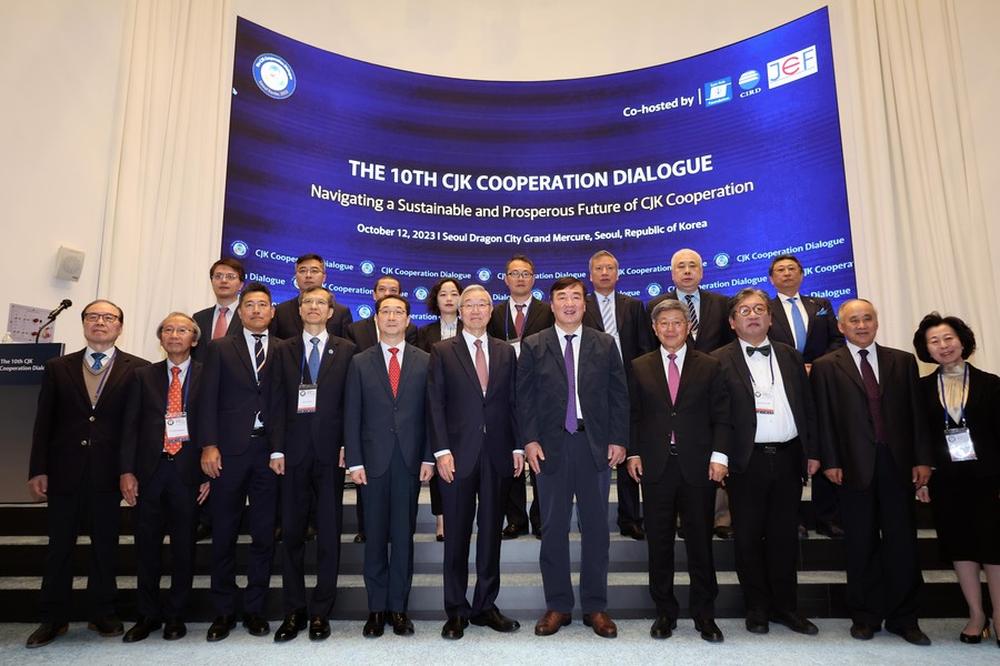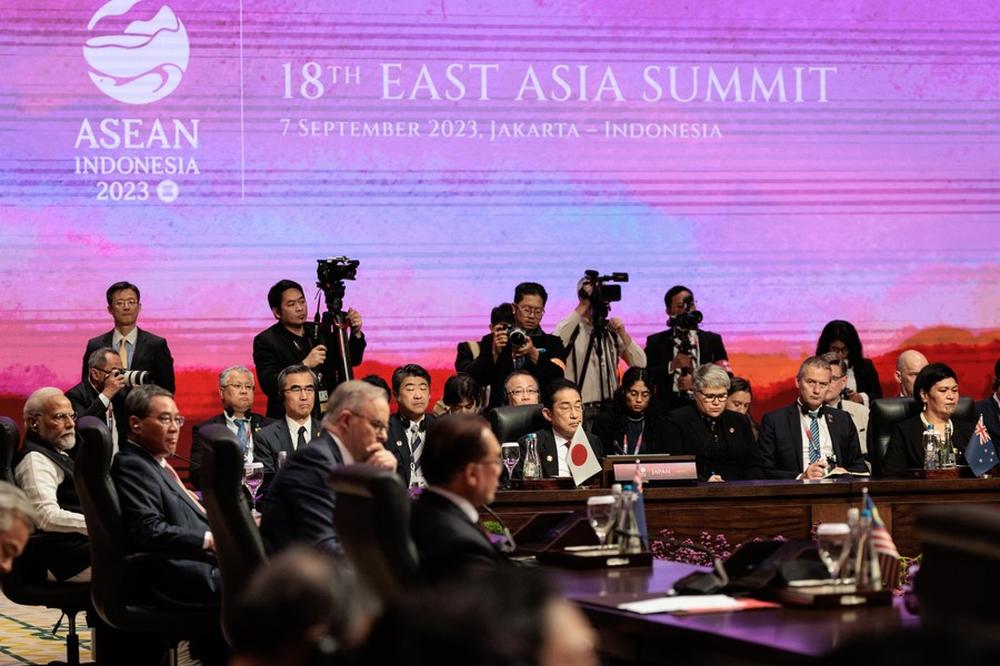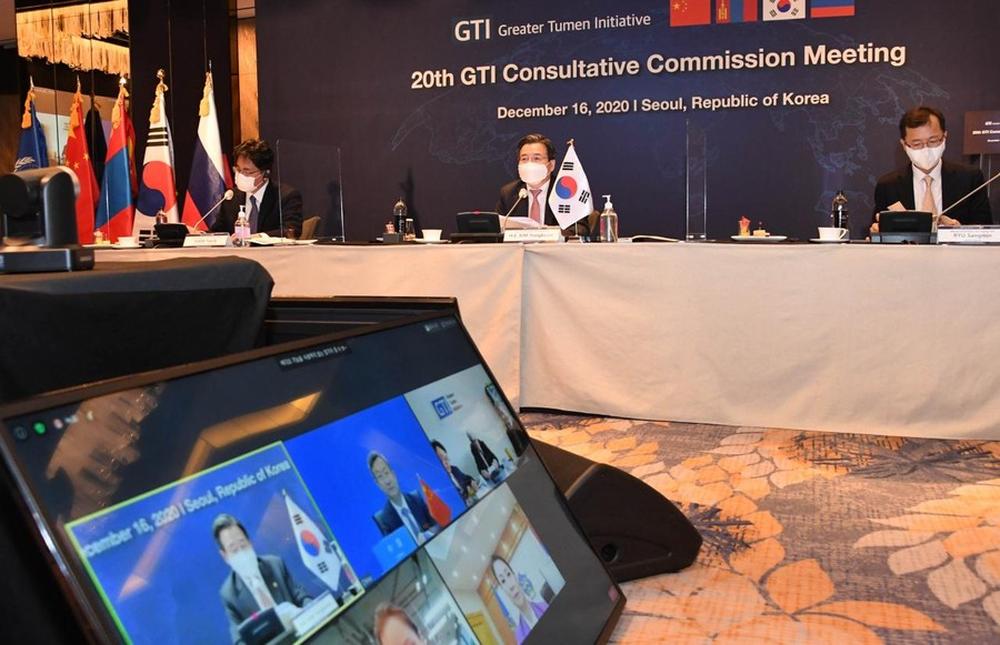- #China
- #Economy & Trade
- #Japan
- #Multilateral Relations
- #South Korea

► With the latest 10th China-Japan-ROK(CJK) Cooperation Dialogue in Seoul in 12th October, 2023, the cooperation areas of CJK trilateral cooperation is expected to expand from the traditional trade and investment to the science and technology, poverty reduction, climate change, cooperation mode innovation, cooperation evaluation etc.
► Once for a while, the trilateral cooperation between China, Japan and South Korea became stagnant, which made the prospects of integrating the two major markets of Southeast Asia and Northeast Asia and then constructing a unified regional cooperation market difficult to materialize.
►Although the CJK trilateral cooperation has encountered ups and downs, the benefits of cooperation of the three countries are obviously greater than the negative implications of suspicion and prevention.
1. The historical process of CJK trilateral cooperation
The launch of ASEAN+3 (10+3) after the 1997 Asian Financial Crisis provided hope for those who believes in regionalism and multilateralism. The “10+3” framework also provided an opportunity for the leaders of China, Japan and South Korea to sit together and discussed the possibility to establish a cooperation framework for the regional development. The trilateral cooperation of the three countries was within the framework. The leaders of the three countries met for breakfast at the “10+3” summit to discuss the issues related had become a convention since then. Many academics expected that the gradual intensification of new regionalism in East Asian would create a new form of world order that can transcend the historical and ideological differences.
After the 2008 world financial crisis, regionalism in East Asia appeared to be on a "declining" trend. In addition to ASEAN, the norm-setter of East Asian regionalism, showing a serious inward tendency. To tackle the crisis, the communication channel of China, Japan and South Korea has remained and intensified. The leaders of the three countries started to meet regularly outside the “10+3” mechanism. From 2008 to 2019, the leaders of the three countries met 8 times. At these meetings, the joint statement for partnership for the three countries were released. The secretariat, the mechanism, the functions and the future direction of the trilateral cooperation of the three countries were established. The smooth communication not only provided opportunities for the three countries to explain their position, but also paved a new path for regional cooperation and integration. The successful signing of Regional Comprehensive Economic Partnership (RCEP) agreement in 2020 is a historic milestone for the regionalism of East Asia and will play a significant role in maintaining economic dynamism of the region. With the latest 10th China-Japan-ROK(CJK) Cooperation Dialogue in Seoul in 12th October, 2023, the cooperation areas of CJK trilateral cooperation is expected to expand from the traditional trade and investment to the science and technology, poverty reduction, climate change, cooperation mode innovation, cooperation evaluation etc.
2. The significance of CJK trilateral cooperation
The CJK trilateral cooperation mechanism has increasingly become a “weather vane” of the bilateral and trilateral economic cooperation and a “ballast stone” for maintaining overall diplomatic stability and security of the region and beyond. The fruits of cooperation between the three countries have proven that trilateral cooperation has promoted the development and prosperity of the three countries in real terms.
From the country perspective, taking the year 2022 as an example, for China, Japan and South Korea were respectively China’s fifth and fourth largest trading partners, second and third largest sources of foreign investment. The industrial and supply chains built by Japanese and South Korean companies in China have become an important part of regional integration and even global value chain cooperation. For Japan, China and South Korea were respectively its largest and fourth largest trading partners in 2022. The two countries have become markets for Japan's mature technologies and core components, recipients of the transfer of its mid-to-high-end industries, and target countries for Japanese investment. Cooperation with China and South Korea continues to be a key factor contributing to Japan's economic growth and corporate profits. For South Korea, China and Japan were respectively its largest and third largest trading partners, second and fourth largest sources of foreign investment in 2022. China and Japan have become the flexible expansion zones of South Korea's characteristic industrial and supply chains, as well as incubators for the continuous enhancement of the competitiveness of "Made in Korea" and its products.
From the regional perspective, the combined economic scale of the three countries accounts for 95% of Northeast Asia, 90% of East Asia, 70% of Asia, and 25% of the world. Before the COVID-19 pandemic, personnel exchanges among the three countries exceeded 28 million person-times at its peak. As key members of RCEP, the successful functioning of CJK trilateral cooperation will not only play a significant role of “ballast stone”, but also greatly accelerate the process of RCEP implementation, further contributing to the economic regional integration and prosperity of the region. More importantly, as inseparable neighbors within the Confucian cultural circle, the trilateral cooperation of the three countries can serve as a model of new regionalism with close geography, affinity between peoples, connected cultures and interlinked emotions. In the next two years, Japan and South Korea will serve as non-permanent members of the UN Security Council in succession. Together with China as a permanent member, the international community has high hopes for how China, Japan and South Korea can play a positive role and demonstrate cooperative responsibility within the UN system. Overall speaking, strengthening the trilateral cooperation of the three countries is of significance to the stability, development and prosperity within and beyond the three countries as well as the region.
3. The challenges faced by CJK trilateral cooperation
The cooperation among China, Japan and South Korea has never been as smooth as people expected. Several factors contribute to the ups and downs of the trilateral cooperation. First, Japanese government’s attitudes toward history and territorial disputes have been negatively influencing the trilateral cooperation. Over the past years, due to Japan's intermittent challenges to the bottom lines of China and South Korea on issues such as territorial disputes and World War II history, China-Japan-ROK cooperation has been seriously disrupted.
Secondly, external intervention from the US influences the domestic agenda of Japan and South Korea. The US has stepped up its intervention and attempted to separate China-Japan-ROK relations, molding US-Japan-ROK ties into a direct military alliance to leverage Japan and South Korea as frontline bases to contain China. The mistrust created by the intervention cause the three countries never prioritize the trilateral cooperation over other competing platforms.
Thirdly, with the rise of China’s economy and global influence, Many Japanese and South Korean perceive China as a threat rather than a reciprocal partner, particularly the incumbent governments. After losing its 2nd largest economy position to China, Japan has become cautious in cooperating with China with the worry that it may further fall behind China and lose its influence within the region.
Last but not the least, Japan's discharge of nuclear-contaminated water into the ocean and other negative factors have stacked up, leading to CJK cooperation centered on "economics and trade" being eroded by suspicion and anger. Actions permeated by "new Cold War" thinking are wearing down prospects formed by decades of cooperation.
Once for a while, the trilateral cooperation between China, Japan and South Korea became stagnant, which made the prospects of integrating the two major markets of Southeast Asia and Northeast Asia and then constructing a unified regional cooperation market difficult to materialize. “Institutional stagnation”, “frustrated regionalism”, and even “disguised multilateralism” began to become frequently used words to describe regional cooperation. The political divergence between China and Japan, Japan and South Korea imposed threat to the progress of the block building in the region.
4. The new prospect of CJK trilateral cooperation
Although the CJK trilateral cooperation has encountered ups and downs, the benefits of cooperation of the three countries are obviously greater than the negative implications of suspicion and prevention. The most recent communication among the diplomats of the three nations created a favorable environment for the resumption of mechanism of the leaders’ meeting. The top diplomats of the three countries also reiterated the significance of trilateral cooperation. In the near future, the CJK trilateral cooperation will move toward the following new prospects:
First, with the push and accelerating role of RCEP, the CJK-Free trade agreement (FTA) will become a de facto reality. In fact, under the RCEP framework, China-Japan and Japan-Korea have achieved free arrangements for trade in goods for the first time. Economic and trade relations between China, Japan and South Korea are expected to further improve. This means that RCEP has in effect laid the institutional and regulatory groundwork for a trilateral free trade zone. Its eventual establishment will no longer be starting from scratch, but building on the foundation of RCEP, thus lowering the difficulty.
Second, the modality and trajectory of cooperation will become more diverse. Besides “10+3”, RCEP and East Asia Summit, “3+X” will become a new modality of cooperation within the region and beyond. The CJK trilateral cooperation will not only cover the entire Asia-Pacific region geographically, but the standards that need to be followed for cooperation will also be further elevated. In terms of cooperation paths, in addition to liberalization and facilitation of trade and investment, trilateral cooperation will also extend to areas such as industrial capacity cooperation and economic and technological cooperation and consolidation of the regional industrial value chains.
Finally, the three parties will explore cooperation in the areas of regional security and common values. In the long run, CJK trilateral cooperation will also shift from mechanism-based cooperation to institutionalized cooperation. The vulnerability of CJK trilateral cooperation caused by suspension and external intervention will finally be offset by the institutionalized cooperation based on common values, openness, mutual respects and equality, and aspiration for common prosperity. Keeping these new prospects in minds, the CJK trilateral cooperation will be heading to a stable and prosperous future.
Dr. Chuanhong ZHANG is a professor at College of Humanities and Development Studies/ and Director of Center for International Development Cooperation Studies at College of International Development and Global Agriculture (CIDGA), China Agricultural University. Prof. Zhang also serves as the Secretary of China International Development Research Network (CIDRN) and acts as the focal point of China Chapter of Network of Southern Think-tanks (NeST). She was an academic visitor of the China Centre at University of Oxford and a visiting scholar of the Department of Political Science at the University of California, Davis. Her research cover both China’s domestic transformation and international development cooperation, specifically on China’s poverty reduction, China-Africa Agricultural Cooperation, Gender and Development, etc. She published quite a few papers on peer-review journals such as the World Development, Journal of International Development, Studies of Comparative International Development, China Perspectives, IDS Bulletin, etc.

